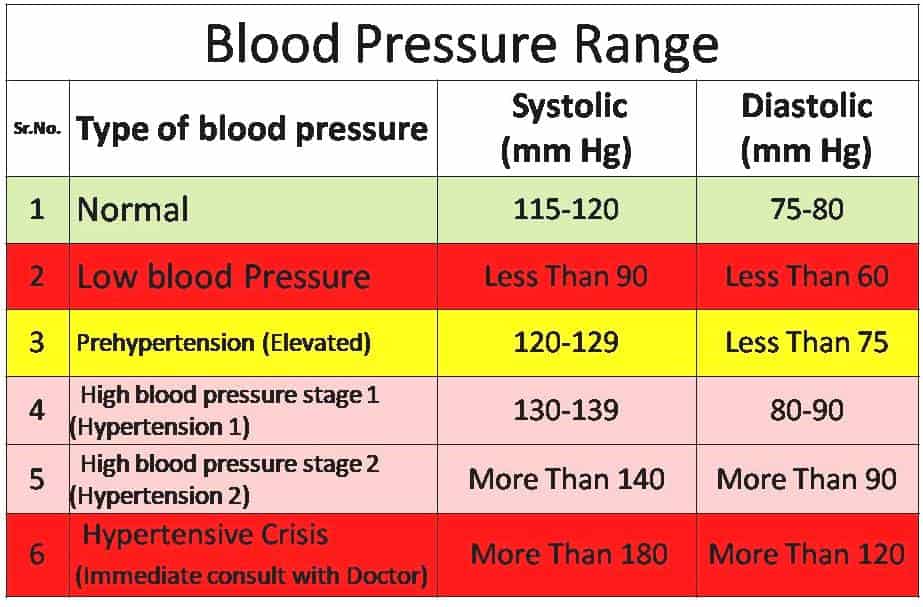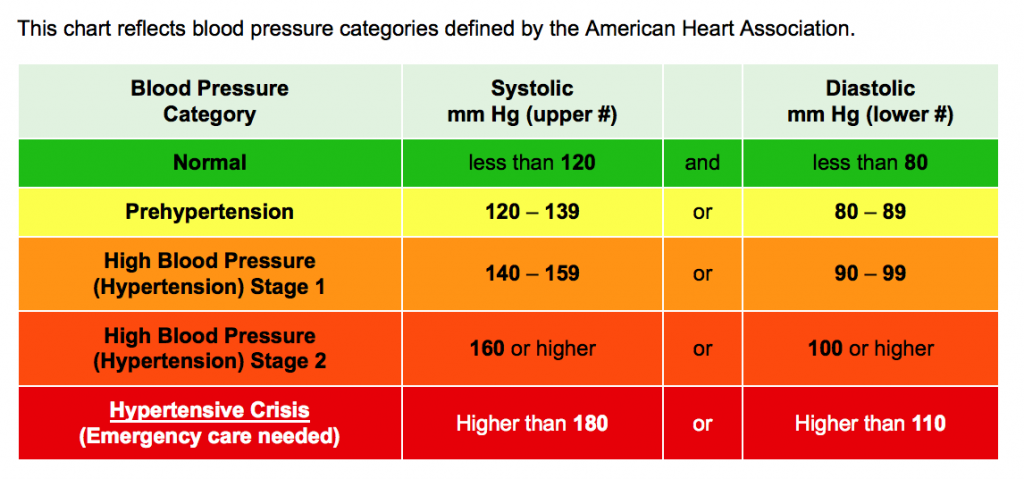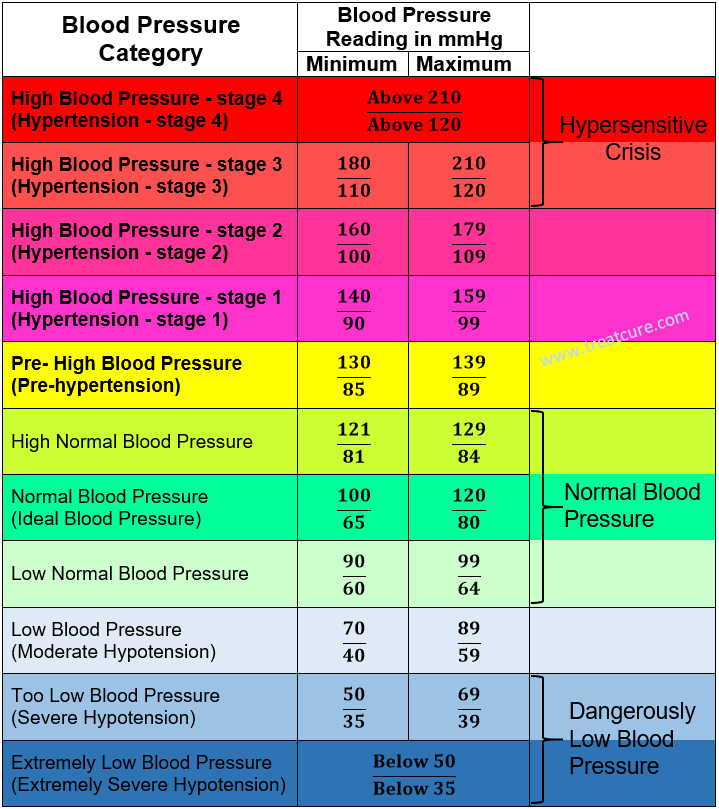Low Blood Pressure Symptoms
Low blood pressure is pressure so low it causes symptoms or signs due to the low flow of blood through the arteries and veins. When the flow of blood is too low to deliver enough oxygen and nutrients to vital organs such as the brain, heart, and kidney, the organs do not function normally and may be temporarily or permanently damaged.
Unlike high blood pressure, low blood pressure is defined primarily by signs and symptoms of low blood flow and not by a specific blood pressure number. Some individuals routinely may have blood pressure numbers of 90/50 with no symptoms and therefore do not have low blood pressure. However, others who normally have higher blood pressure may develop symptoms of low blood pressure if their blood pressure drops to 100/60.
During pregnancy, blood pressure tends to decrease. Normal blood pressure during pregnancy may be lower than 100/60. Your ob-gyn or Midwife should monitor your blood pressure if you are pregnant.
Checking Blood Pressure At Home
Keeping track of blood pressure at home is important for many people, especially if you have high blood pressure. This helps you and your doctor find out if your treatment is working.
Your doctor may also suggest that you check your pressure at home if they think you may have white coat hypertension. Its a real condition. The stress of being in a doctors office raises your blood pressure, but when youre home, its normal.
Ask your doctor to recommend an easy-to-use home blood pressure monitor. Make sure the cuff fits properly. If your arm is too big for the cuff, the reading may be higher than your blood pressure really is. Ask your doctor for a larger cuff or make sure you buy a home monitor with a cuff that fits you.
You also can use a wrist blood pressure monitor, but they often arent as accurate. Follow the directions that come with the device to make sure you are using it correctly.
No matter which type of blood pressure monitor you have, its a good idea to take it to your doctors office. You can compare its reading to the numbers your doctor gets. Avoid caffeine, cigarettes, and exercise for at least 30 minutes before the test.
When you take your blood pressure at home, sit up straight in a chair and put both feet on the floor. Ask your doctor or nurse to show you the right way to position your arm so you get accurate readings.
Defining Hypotension And Its Symptoms
Definition: Blood pressure reading of 90/60 or lower
Hypotension, or low blood pressure, means blood is not fully flowing to your brain, arteries, and organs. Chronic low blood pressure without symptoms is almost never cause for concern, unless blood pressure drops suddenly and the brain is deprived of adequate blood supply. This can lead to dizziness or lightheadedness. Other symptoms include:
- Unsteadiness
- Fainting
- Pale skin
While it isnt entirely clear what causes low blood pressure, it may be associated with age, pregnancy, hormonal problems , some over-the-counter/prescription medications, heart failure or arrhythmias, widening of blood vessels, heat exhaustion, heat stroke, or liver disease. To combat hypotension, there are a few options including eating a diet higher in salt, staying hydrated with nonalcoholic beverages, and exercising regularly.
Recommended Reading: Blood Pressure How To Lower
How To Diagnose Low Blood Pressure
Blood pressure is measured using two numbers the systolic first and then the diastolic . Blood pressure is measured using an inflatable cuff. This is positioned around the upper arm. The cuff is inflated and the doctor or nurse listens to the artery just below the cuff as the air is then released.
When they can hear the heartbeat, they will record the systolic pressure. When the sound disappears, they will record the diastolic pressure. Sometimes an automatic blood pressure recording machine is used. Blood pressure may be measured while lying down and then while standing. Blood pressure has to be checked regularly.
What is the treatment of low blood pressure?
Low blood pressure or hypotension may or may not require treatment. The treatment of hypotension is directed toward the underlying cause. Checking whether you are drinking enough and are not dehydrated may be important. If an underlying disorder, such as a heart condition, is suspected, then it may be advisable to go to the hospital for tests and treatment. If medications are suspected of causing hypotension, the doctor will probably advise a change of drug or dosage. Bed rest and help with daily activities are needed until the condition improves.
How to prevent low Blood pressure?
What Do You Do If A Patient Is Hypotensive

Treatment
You May Like: What Causes Hypertension Stage 2
What Are The Symptoms
Many people with low blood pressure don’t have any symptoms.
Symptoms to watch for include:
- Feeling dizzy, light-headed, or faint.
- Feeling sick to your stomach or vomiting.
- Feeling more thirsty than usual.
- Having blurry vision.
- Breathing very fast.
If you have symptoms of low blood pressure, especially dizziness or fainting, call your doctor.
Watch for symptoms of low blood pressure. Tell your doctor when the symptoms happen so he or she can treat them.
What Tests May Help Find The Cause Of My Hypotension
Many times, hypotension is a symptom of another condition. You may need any of the following tests to find the cause of your hypotension:
- Blood tests: A sample of your blood or urine may be checked for anemia or other conditions causing your hypotension.
- EKG: This test records the electrical activity of your heart. It is used to check for damage or other heart problems that may be causing your hypotension.
- Autonomic nervous system tests: Your healthcare provider may check for changes in how fast your heart beats when you take deep breaths. He may also check for changes in your BP while you put your hand in ice cold water.
- 24 hour urine test: During this test you will need to collect all of your urine for 24 hours. You will urinate into a container and the urine will be put into a jug. The jug will need to be kept cold. If you urinate during the night, you will need to save that urine. Healthcare providers will measure and record how much you urinate. At the end of 24 hours, the urine will be sent to a lab for tests.
- Echocardiogram: This is a type of ultrasound, also called an echo. An ultrasound uses sound waves to show pictures of your heart on a monitor. An ultrasound may be done to show how your heart moves when it beats.
Recommended Reading: Is Beets Good For High Blood Pressure
How To Check Your Blood Pressure
You can check your blood pressure:
- at home yourself using a home blood pressure monitor talk to your GP about home monitors
Low blood pressure is a measurement of 90/60mmHg or lower.
The first number is the highest pressure when your heart beats and pumps blood around your body. The second number is the lowest pressure when your heart relaxes between beats.
See a GP if you have low blood pressure and keep getting symptoms such as dizziness.
Serious Injuries And Shock
Low blood pressure can also be caused by serious injuries or burns, particularly if you have lost a lot of blood. This can mean that there is less blood being pumped around your body. Low blood pressure can also occur if you go into shock after having a serious injury.
Other kinds of shock are described below.
Anaphylactic shock
Anaphylactic shock, or anaphylaxis, is caused by an allergic reaction to something – for example, a wasp sting or a peanut. During an allergic reaction, your body produces a large amount of a chemical called histamine, which causes your blood vessels to widen and leads to a sudden, severe drop in blood pressure.
Cardiogenic shock
Cardiogenic shock occurs when your heart cannot supply enough blood to your body, so your blood pressure drops. This can happen during a heart attack.
Recommended Reading: How To Lower High Diastolic Blood Pressure
How Can You Bring Your Blood Pressure Down Quickly
Here are some simple recommendations:
Low Blood Pressure In A Teenage Girl
Sometimes, teenage girls tend to have hypotension and episodes of unconsciousness during menstruation. This could be triggered due to pain or heavy bleeding during menstruation, or due to vasovagal syncope.
Vasovagal syncope is a reflex disorder that leads to transient loss of consciousness. This is characterized by symptoms, such as acute visual disturbance, auditory disturbance, cognitive slowing, followed by hypotension with lightheadedness and loss of consciousness. However, studies found that the severity of lightheadedness changes during the menstrual cycle and was found to be similar in both VVS patients and healthy individuals.
Also, VVS patients were not found to have any greater risk of gynecological abnormalities and pregnancy complications when compared to otherwise healthy individuals. .
A few changes in lifestyle, such as taking adequate fluids and salts plus moderate exercise, can help manage this condition. However, if your teenager is having frequent episodes of lightheadedness during her periods, then it is best to schedule an appointment with a gynecologist.
Observe the symptoms to know if everything is alright with the child. The next section talks about diagnostic methods for low blood pressure in children.
Also Check: How Much Does Metoprolol Lower Blood Pressure
Possible Complications And Risks
In some cases, your blood pressure can drop so low that your body goes into shock. This is because without proper blood flow your organs dont get enough oxygen. Signs that your body is going into shock include feeling clammy with cold but sweaty skin, faster breathing, and a rapid pulse.
If you experience these symptoms it is imperative that you seek medical attention. The greatest risk lies in not addressing your low blood pressure. Talk to your doctor about any blood pressure-related concerns you have.
Are Orthostatic Hypotension And Postural Tachycardia Syndrome The Same Condition

Postural tachycardia syndrome, or POTS, causes symptoms similar to orthostatic hypotension. Both cause dizziness or fainting upon standing. Along with a drop in blood pressure, POTS causes a heart rate increase of 30 to 40 beats per minute within 10 minutes of standing. POTS is less common than orthostatic hypotension.
Also Check: Why Do You Have High Blood Pressure
What To Do If You Experience A Sudden Drop In Blood Pressure
A single low blood pressure reading is no cause to be concerned unless you experience other symptoms.
A sudden drop in blood pressure as little as a drop from 120 to 100 in your systolic number can be dangerous if it triggers dizziness and fainting. Such symptoms can be a sign of an underlying problem that may need medical attention.
You should keep a record of your activities and when symptoms happen to discuss them with your doctor. If you experience any low blood pressure symptoms related to shock, you should seek immediate medical attention.
What Is Normal Blood Pressure
For years we have been told that a normal blood pressure reading is 120/80 however, more and more doctors have now lowered these numbers to 115/75. Blood pressure is different for everyone as many factors can have an effect on the numbers.
Our blood pressure refers to the amount of force behind the blood as it hits the arterial walls. As the heart pumps the blood, an ideal pressure sees the blood push against the walls that are flexible enough to expand and retract easily. Over time, our age, diet, and physical activity play a role on the elasticity of our blood vessels. With a loss of flexibility due to hardening of the walls, the heart needs to work harder to push the blood.
These factors determine the blood pressure numbers. The systolic number is the top number, and it indicates the pressure as the heart beats or pushes the blood throughout the body. The diastolic number is the bottom number, and refers to the pressure in the arteries when the heart rests between beats. During this time, the heart receives oxygen as it fills with blood.
Recommended Reading: Do Allergy Pills Raise Blood Pressure
You May Like: What Is The Normal Blood Pressure By Age
Effective Home Remedies For Low Blood Pressure
- NDTV Food
While you may have heard of hypertension or high blood pressure, suffering from low blood pressure can be as dangerous as well. An optimal blood pressure reading is less than 120mm Hg and above 80 mm Hg. The first number indicates the systolic pressure or the pressure in the arteries when the heart beats and fills with them with blood. The second number represents the diastolic pressure which is the pressure in the arteries when the heart rests between beats. Low blood pressure or hypotension may cause inadequate blood flow to the heart, brain, and other vital organs. A sudden drop in blood pressure often occurs when someone suddenly rises from a lying down or sitting position. This is called postural hypo-tension and may cause light-headedness and dizziness. There are some home remedies for low blood pressure that you can employ in order to deal with the symptoms of erratic blood pressure. But if youve been feeling the following symptoms for a while, consult your doctor and get your blood pressure measured
- Fatigue
- Loss of consciousness
- Blurry vision
Once your doctor confirms that your blood pressure is low, follow his advice and take medication if required. A healthy low blood pressure diet is important for low blood pressure treatment. Along with that, heres more homely help. Your diet plays a crucial role in maintaining your blood pressure.
What Is Blood Pressure
Blood pressure is the force of blood pushing on the artery walls as it is pumped out of the heart. Blood pressure is measured in two kinds of pressures. Systolic pressure is when the heart beats while pumping blood. Diastolic pressure is when the heart is at rest between beats.
Blood pressure is measured in millimeters of mercury . Systolic pressure is listed first , then diastolic pressure .
Normal blood pressure in adults is less than 120/80 mmHg.Low blood pressure is a reading below 90/60 mmHg.
Most forms of hypotension happen because your body can’t bring blood pressure back to normal or can’t do it fast enough.
For some people, low blood pressure is normal. They have it all the time, with no symptoms or negative side effects.
In other people, abnormally low blood pressure is caused by certain medical conditions or factors. When this happens, less blood and oxygen flow to the body’s organs.
Recommended Reading: How To Reduce High Blood Pressure Immediately
Should I Go To Urgent Care For Low Blood Pressure
Normally low blood pressure is not a matter of concern unless it causes trouble. Sometimes people dont even know about them having low blood pressure but there are some conditions that need urgent care when having low blood pressure. Pregnancy is one of them.
Low blood pressure pregnancy can lead to many complications. The shock caused by low blood pressure is the most serious condition. If someone is suffering from heart disease then he/she must take low bp seriously.
There are some problems like fast breathing caused by low blood pressure while sleeping. Above mentioned situations need urgent care from doctors.
Summary: Low blood pressure normally does not need more attention but cant be ignored completely too. It gives rise to many serious problems that need to be cured as soon as possible.
When Is Low Blood Pressure Too Low Hypotension And More
Some people naturally have low blood pressure, known as hypotension. However, when high blood pressure suddenly becomes low blood pressure, it could be cause for concern.
Shutterstock
Low blood pressure, or hypotension, may be a sign of good health and of a decreased risk of heart disease. But not always. At times, continually low blood pressure or a sudden drop in blood pressure can lead to worrisome symptoms and even serious health problems.
You May Like: Do Eggs Cause High Blood Pressure
How Do I Take Care Of Myself
If you have hypotension with symptoms, the best thing you can do is follow your healthcare provider’s guidance on managing this condition. Their recommendations may include any of the following:
- Manage your diet. Following diet recommendations, especially how much salt you should have in your diet, can help avoid symptoms of hypotension.
- Take your medication. These can help you avoid the disruptive symptoms and effects of this condition.
- Dress up. Compression socks, which put light pressure on your legs and feet, can push blood upward and raise your blood pressure.
- Take it slow. Avoid standing up too quickly, especially with orthostatic hypotension. That can help you avoid the dizziness and fainting effects of hypotension.
- Have a seat. If you notice yourself feeling dizzy or lightheaded, sit down. Falling from standing height can put you at risk for severe or even catastrophic injuries from a fall, such as a broken hip, concussion, skull fracture or broken ribs.
When To See Your Gp

You should see your GP if you have frequent symptoms of low blood pressure. Your GP can measure your blood pressure and help identify any underlying causes of the problem.
All adults should have their blood pressure checked at least every five years. If you haven’t had yours measured or don’t know what your reading is, ask your practice nurse or GP to check it.
Also Check: How Does Smoking Increase Blood Pressure